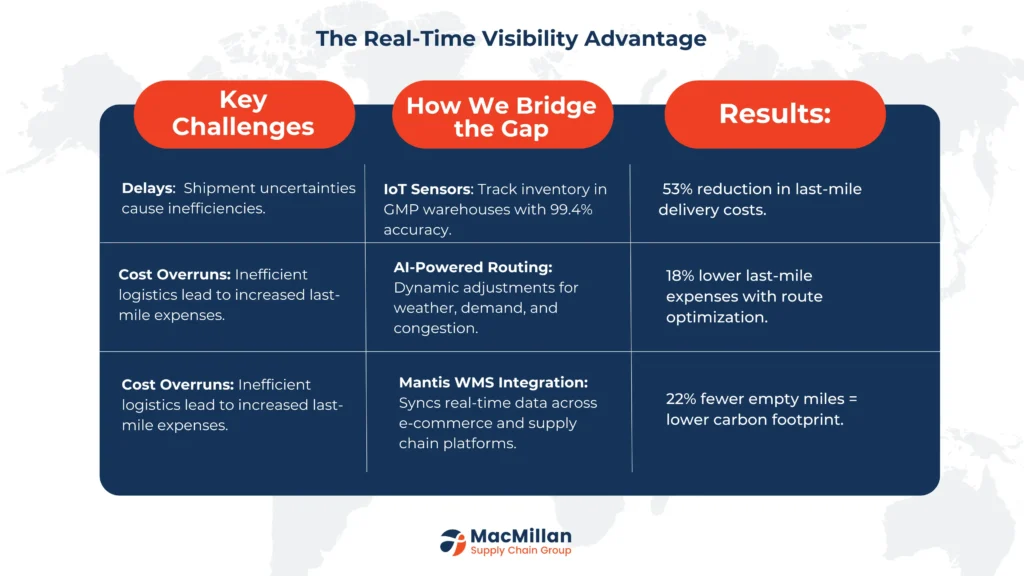In today’s hyperconnected world, customers no longer settle for vague delivery windows or generic tracking updates. Every link in the supply chain is affected by their demands for accuracy, transparency, and control. Businesses now need to use cutting edge solutions to transform visibility into a competitive advantage rather than merely keeping up. At Macmillan Supply Chain Group (SCG), we’ve built our Canadian logistics solutions around this reality, empowering brands to meet modern demands with agility and confidence.
The Rise of Real-Time Expectations in Supply Chains
The digital age has rewired consumer behavior. Thanks to giants like Amazon, next-day delivery and minute-by-minute tracking are now baseline expectations. But this urgency doesn’t stop at the consumer level as it cascades through every tier of the supply chain. Retailers, manufacturers, and distributors all require instant insights to optimize operations, reduce costs, and maintain trust.
Consider this: 45% of supply chain executives identify real-time inventory visibility as a critical challenge, yet only 31% of companies actively use live data to inform decisions. This gap highlights a pressing need for solutions that bridge the divide between legacy systems and modern expectations.
Why Real Time Data Matters Now More Than Ever
- Customer Trust Hinges on Transparency
When a customer orders a product, they’re not just buying an item they’re investing in a promise. Real-time tracking transforms this promise into a tangible experience. For instance, Macmillan SCG’s AI-driven platform provides clients with live updates on shipments, from warehouse dispatch to final delivery. This level of detail minimizes “Where’s my order?” inquiries and builds loyalty by aligning every stakeholder brands, suppliers, and end consumers on a single source of truth.
- Operational Agility in Disruptive Times
Rapid pivots are necessary due to shifting demand, port congestion, and geopolitical issues. Businesses using real-time data relocated shipments in a matter of hours during the 2024 Red Sea shipping crisis, saving rivals weeks of delays. With over 3,000 committed drivers and 45 cross-docking points, Macmillan’s network is built for such agility. Predictive analytics is used to anticipate problems and dynamically recalculate routes.
- Sustainability Through Smarter Decisions
Efficiency is more important than speed when it comes to real-time visibility. Businesses can decrease waste and lower their carbon footprint by keeping an eye on inventory levels, transportation routes, and fuel consumption. These findings are integrated into Macmillan’s Net Zero Journey initiative, which helps clients avoid idle miles and optimize load planning, thus bringing revenue and environmental responsibility into direct alignment.

How Macmillan SCG Delivers Real-Time Visibility
Precision in Warehousing: Beyond Storage to Strategic Insight
Our GMP certified warehouses across Toronto aren’t just storage hubs; they’re data goldmines. With 250,000+ square feet of racked and bulk space, we deploy IoT sensors and Warehouse Management Systems (WMS) to track inventory levels down to the SKU. This granularity enables:
Same day fulfillment with 99.4% pick accuracy, reducing costly errors.
-Predictive restocking alerts that sync with supplier portals, preventing stockouts.
-Climate-controlled monitoring for sensitive goods, ensuring compliance and quality.
Last-Mile Mastery: Turning Delivery into a Differentiator
Efficiency is crucial because last mile logistics account for 53% of overall shipping expenses. Macmillan’s devoted fleet analyzes traffic patterns, weather information, and delivery windows in real time using AI powered routing software. This implies:
– 90% of Canadian FSAs (Forward Sortation Areas) serviced next-day.
– Dynamic ETAs shared with customers via SMS or app notifications.
– Reduced “failed delivery” attempts through geofencing and recipient communication tools.
Seamless Integration: Making Data Work for You
Data silos are frequently produced by legacy systems’ inability to connect with modern platforms. By providing plug and play connectivity with popular e-commerce systems like Shopify and WooCommerce, our Mantis WMS removes these obstacles. Clients gain during migration from:
– Zero downtime through parallel system testing.
– Automated data synchronization across sales channels.
– Custom dashboards that unify inventory, shipping, and demand forecasts into a single view.
Overcoming Visibility Challenges with Tailored Solutions
Challenge 1: Fragmented Data Across Multiple Systems
Many companies use different systems for logistics, CRM, and inventory management. These streams are combined by Macmillan’s API-driven technology, which provides a single analytics hub. For instance, after matching production schedules with real-time sales data, a cosmetics firm that used our solution cut overstock by 22%.
Challenge 2: Balancing Speed and Cost
Hasty shipments can reduce profit margins. Our lane density optimization technology allows shared truckloads without sacrificing speed by grouping deliveries by region. One customer kept their promise of same-day delivery while reducing last-mile expenses by 18%.
Challenge 3: Ensuring Data Accuracy
Outdated spreadsheets and manual entries invite errors. By automating data capture through barcode scanners and IoT devices, we’ve achieved near-zero inventory shrinkage, a critical advantage for high-value industries like pharmaceuticals.

The Future of Visibility: AI, Sustainability, and Beyond
The importance of machine learning in predictive analytics is constantly changing. The R&D team at Macmillan is testing AI models that can:
- Forecast demand spikes by utilizing weather and social media trends.
- Carriers tariffs are automatically negotiated based on capacity and current fuel prices.
- To support ESG compliance, create carbon reports for each shipment.
Conclusion: Visibility as Your Strategic Partner
In a landscape where delays are costly and trust is fragile, real-time data isn’t optional it’s the backbone of resilient supply chains. Macmillan SCG combines Canadian logistics expertise with global-scale technology, ensuring our clients aren’t just reacting to changes but anticipating them.
Whether you’re streamlining e-commerce fulfillment or navigating cross-border complexities, we’re here to transform visibility from a challenge into your greatest asset. Explore the Macmillan Advantage today where every byte of data fuels smarter decisions and every delivery strengthens customer loyalty.
FAQS
Real-time supply chain visibility is the ability to track inventory, shipments, and logistics processes as they happen, using technologies like IoT sensors, AI analytics, and integrated software platforms. This allows businesses to monitor goods from warehouses to final delivery, address disruptions proactively, and share live updates with customers
By identifying inefficiencies like redundant routes, overstocking, or delayed shipments, real-time data enables immediate corrections. For example, Macmillan SCG’s lane density optimization reduces last-mile costs by grouping deliveries regionally, while IoT-driven inventory tracking cuts shrinkage by 99.4%.
Macmillan integrates:
IoT sensors for live inventory tracking in GMP-certified warehouses.
AI-powered routing that adjusts for traffic, weather, and demand spikes.
Mantis WMS, a cloud-based platform syncing data across e-commerce tools like Shopify
Yes. By optimizing delivery routes and load planning, businesses reduce fuel consumption and carbon emissions. Macmillan’s Net-Zero Journey initiative uses real-time data to cut empty miles by 22%, aligning cost savings with ESG goals
Live tracking updates (e.g., SMS alerts, dynamic ETAs) minimize customer inquiries and build transparency. During the 2024 Red Sea crisis, clients using Macmillan’s system rerouted shipments within hours, avoiding delays that cost competitors weeks
Yes. Macmillan’s API-driven solutions integrate with existing ERP, CRM, and inventory tools, erasing data silos. For instance, a beauty brand reduced overstock by 18% after syncing real-time sales data with production schedules




